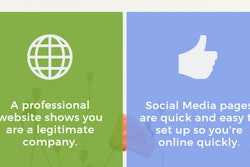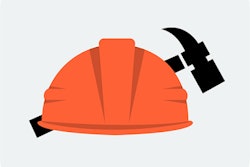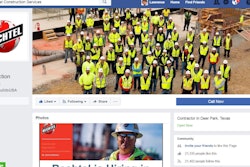
Does your website help make your life easier and your construction business stronger? Your website can and should be working overtime to bring in more of your ideal customer.
If done right, you’re setting yourself up to have your pick of quality lead after quality lead and compete based on strong positioning rather than low pricing.
If done wrong, your business will consistently miss out on opportunities to grow revenue and reduce manual workload.
Why is it a mistake not to prioritize your website as a sales tool? You might be thinking, “I get plenty of business from referrals — I just need a simple brochure website.”
But if that’s the case, it pays to ask yourself: am I getting the right kinds of referrals? Are they predictable? And when I do get a referral, does my website help close the deal or does it send them off Googling?
3 Steps to Building an Effective Web Site for Your Business
A strong, strategic online presence is critical — studies show 82% of people conduct online research before buying. The opportunity cost of ignoring this reality is huge.
If you want a targeted, effective and automated lead generation process online, your website is your first and most important tool.
When construction firms do not use their websites as a sales tool, they often fall prey to eight common mistakes.
1. Not having a clear, simple Call to Action (CTA)
When someone lands on your website, you get about five seconds of their attention. This means you need to concisely convey who you are, what that means for your ideal customer and ask them to take a small action.
Supercharge your construction website’s ability to get leads by creating a simple CTA at the top of your website. This CTA should be based around one strong business goal (e.g., getting people to contact you for a low-pressure consultation). Then, make contacting you even easier by placing that same CTA on each page of the site.
2. Not asking for emails
When someone leaves your website, they’re not likely to come back on their own. So instead of leaving it to chance, stay in front of potential customers via email. This allows you to stay top of mind for when they are ready.
Best practice online typically calls for offering something of value for free in exchange for an email. For construction pros, this could be something as simple as a downloadable guide on what to consider when beginning a major build, where you share specific tips on how to keep the process smooth and on-budget.
The key is to create a small ask, and then explain how small and simple it is. For example, if your CTA is “Download your free guide,” add a subheader that says “It only takes a few seconds”.
3. Overloading the homepage with too much information
Don’t fall into the trap of thinking people need to know everything about your business before making a decision to contact you. The truth is, they need to know just enough to feel informed and reassured that you’re who they want to work with.
By focusing your website’s homepage around one primary business goal (e.g., “We want to do more $1M+ custom homes”), you can position your written content in a way that resonates with the type of customer who would want that service, and funnel users towards the goal you’ve chosen for the site.
Three Types of Website Content to Generate Better Construction Leads
4. Not keeping it up to date
Prospective customers want to see your recent work and feel inspired and reassured by seeing people just like them happily enjoying the benefits of your work. Too many construction websites ignore this completely and rarely, if ever, post updates.
Position yourself as an in-demand, expert firm by including up-to-date case studies from your ideal customers right on your homepage. If you are a commercial construction business and your most recent customers are smiling from ear to ear, write a brief report showcasing what you did, pictures of the end result and your customer’s glowing review.
5. Not answering questions
Part of the sales process is removing objections. An Frequently Asked Questions (FAQ) section can save you time and reassure prospective customers. Simply answer the most common questions you get and lay out what it’ll be like to work with you.
6. Following up too slowly with leads
Studies show companies that reply to customer contacts within an hour generate seven times more conversions than others. Improve your chances by sending contact form inquiries straight to your phone, where you can respond in minutes instead of days.
You can do this with Caldera Forms, Gravity Forms and others.
For an extra boost, construction companies of all sizes are adding in live chat. This adds a level of convenience for anyone browsing your site, and feels more low-pressure than submitting a contact form (which some users worry will lead to getting hounded by sales calls).
This is easy to do with Facebook Customer Chat, which is free and makes use of Facebook Business and Facebook Messenger, both of which you and your employees likely have. Messages from the on-site chat widget feed into your Facebook Messenger app and your business’s Facebook page. This allows your employees with admin access to see any messages that come in.
7. Not optimizing your Google My Business profile
Google My Business is your business’s Google-specific profile. It tells Google who you are, where you are and what you do so that when people search your business name, it shows up in the top right corner of the search results.
And while it’s not directly on your website, it does link to your website and drive traffic there (especially local traffic). It’s easy to optimize and doesn’t require special technical skills. This article from Search Engine Journal walks through the process step–by–step.
The time spent to set this profile up correctly will pay you back in spades.
8. Not showcasing client feedback
Your customers love your work. But these days, most of us read online reviews before making any buying decisions — especially for major investments like building a home. Research shows that 91% of 18 to 34 year olds trust online reviews as much as personal recommendations.
Highlighting recent testimonials is a huge missed opportunity for many construction companies. Put them front and center on your website’s most important pages (not buried on interior pages), so that as prospects are scrolling, they’re consistently seeing social proof that you do top–quality work.
What your customers say about you goes a long way in building trust. Actively pursue testimonials from happy customers soon after you complete the build, when your efforts are freshest in their mind. Get more reviews by sending customers a one-click review link: here’s how to do that with Google.
By avoiding these common construction website mistakes, you’ll immediately set yourself apart and start leveraging the full power of your website to make your life easier and your business stronger.
Connor Kane helps builders and contractors get more leads through digital marketing at Wheelhouse Digital.

















